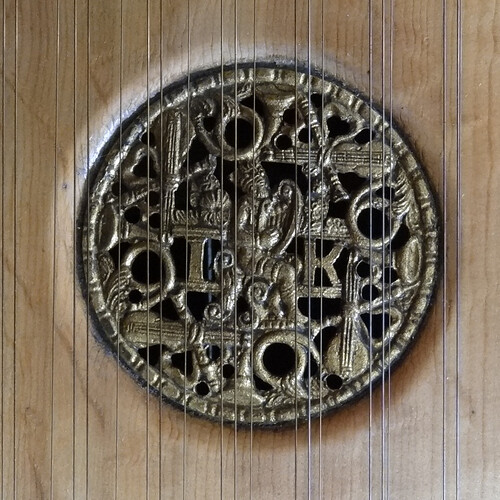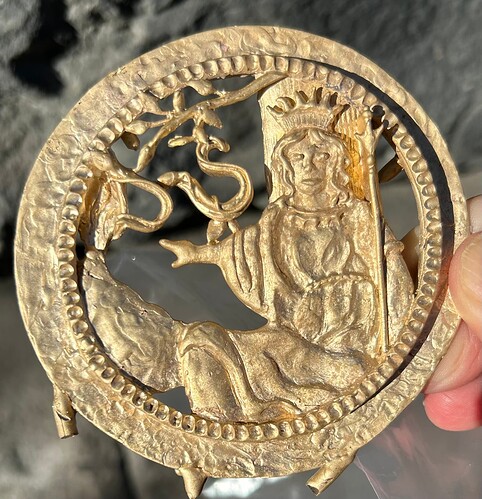Medieval lute was played with a plectrum. Over the 16th century the technique expanded and the hand opened. Early finger technique often used the thumb and first or second fingers held close together, rotating the hand in a plectrum-like motion to play fast runs and repeated notes. As more strings were added and harmonies became wider, the hand had to open wide to reach the strings, probably common by about 1610, the middle of Dowland’s career. There were also smaller lutes played in consort, probably playing single lines, similar to a mandolin.
But then iconographic art often refers to real or imagined earlier instruments, and the hand shape as molded in prettier than an open hand. Wonderfully, the left and right hands are placed correctly to be playing a passage on the fourth or fifth course. Is she swaying in time to the music? Meanwhile, her tiny bare feet have remarkable grasping abilities, and I’m not sure of the species of her truncated, winged audience. It’s really a delightful moment.
Chris Goodwin’s ‘Brief introduction to the lute’ at:
https://www.lutesociety.org/pages/about-the-lute
says that the lute was played with a quill plectrum throughout the
mediaeval period; not sure what his authority is for this. I have seen
modern players use a plectrum in renaissance-period pieces. Perhaps the
change-over from plectrum to fingers occurred somewhere around the late
fifteenth/early sixteenth century, as lute music became more polyphonic?
At any rate, I doubt whether the plectrum in the hands of this lady has
any special symbolic significance.
Maybe not the plectrum by itself, but the iconographers are forever reminding us of the symbolic meanings of pieces such as this. Ed mentions the odd winged creatures. They’re androgens, males faces with female bodies.
The snails, at least (which are also androgens, come to think of it), seems pleased by the music, as we could tell from the expression on their faces if they had faces. There have been a number of articles recently on medieval MS pictures of knights fighting snails. That doesn’t seem relevant, though. I can’t find any refs to snails as emblems of La Musique or St Cecelia or the like. Maybe the lutenist invited them for dinner?
“…not where they eat but where they are eaten” - to coin a phrase.
“After such kindness that would be a dismal thing to do!”
Additionally, kind folk, those of you who may be interested should create ties with both Claudio Casiglia and Massimiliano del Erba via Facebook. Alongside Mateo, they are all acquaintances of mine whom I deeply respect, and both of them are true artisans! I offer you my best wishes for success ![]()
I’m fairly sure the 2 winged creatures in the Jean Denis ii rose are bearded sirens (common in antique representations, search for “bearded siren”). If so, it’s an inversion of Odysseus’ encounter: not a man, but a woman who plays (rather than listening) to sirens, whatever their sex if they have one. Maybe there are also hints of a female Orpheus, since her music has the power to move snails.
Michael
This might make a good rose too, a siren without the human body. Afraid I don’t know the Greek source or location of the object. By the way, Matthias Griewisch makes exquisite roses, for example on his clavicytheria.

Google image search says that it’s a:
Bearded siren. Plate, Middle Corinthian, ca. 580/70 BC. From Boeotia
now in the Louvre
https://www.hellenicaworld.com/Greece/Mythology/en/SirenLouvreCA1629.html
It’s wonderful! Unfortunately for me, my immature sense of humor kicked in and now I can’t unsee that it’s pooping.
John’s roses, like all the art on his instruments, are utterly spectacular. They are made by Janine Johnson, who if she had the time, might be willing to design and make one for Domenico. Do we have a feature that allows a private message to Domenico?; I am reluctant without prior permission to spread anyone’s contact information about publicly.
Use the web interface. Click on the username for the post. Then select ‘Message’. Simple. Built in to Discourse from the start.
Can’t be done by the mail interface, obviously.
Thanks Andrew. As it happens, Domenico is a FB friend, and I dropped him a line there, but I’m glad to learn how to do what those who visit the site more frequently all know already!! I think when I get a notice and am curious that I am loading the web interface, not via mail.
I agree, by the way, about the Vogel ‘rose.’ Dear heavens. I don’t know whether Janine would be willing to take something like that on, but she might. Her skills are of the very highest order.
owen
Thanks a lot Owen. Tomorrow I’ll see a local (Naples, Italy) jewel designer and maker who makes them by the lost wax process, so she should be proficient in wax sculpting. If she refuses, or if I am not sure she can do, I’ll write to Janine Johnson. I have seen some very beautiful decorations by her.
Dear Domenico
Variations on the harp-playing angel are certainly the most popular cast metal roses. The simplest have a flat surround, with the bevel is cut into the soundboard. Others, like the Tomlinson model, have a surrounding ornamental ring. The Hubbard rose with its organist was based on Hemsch originals.
It’s a big ask to expect a maker to release his own rose for others to use. As Andrew suggests, you might enjoy making your own. I think you would be better off visiting a wood carver than a jeweller, who would carve the master for you out of limewood. You could then make a mould of that. Silicone mould making materials are readily available. You would then cast either resin or metal as you prefer, and gild it.
As for any desirable acoustic effect of a metal rose, I always found the Arakawa article interesting. All the response and loudness curves are quite jagged with large variations between maximum and minimum, no matter what the criterion. I could point to a number of makers who use resin roses without detriment, or even great historic instruments without a soundboard rose, like the 1769 Taskin (Edinburgh), or the 1775 Collesse (Paris), which has a painted vase of flowers instead.
Finally, while we are looking at examples of roses, I should share the extraordinary 1773 Jacob & Abraham Kirckman rose, with its menagerie of assorted instruments surrounding King David playing his harp.
Regards
Carey
That is excellent news. I had, when I was first starting out, a gifted jeweler make me a hand-carved model for a cast lead rose. It was magnificent, though I only used it I think twice, but he didn’t use lost-wax, but, instead, some kind of neoprene mold. When he quit jewelry to become a marine biologist he gave me the original model, which he had cut in sterling silver, but I’m mortified to say that although I KNOW it is around the house or shop somewhere, frantic and diligent searches over the course of many, many years have still failed to turn up the mold OR the original model. I asked him to use as a model a good photograph of an original rose, but I forget from which maker.
Yes Carey, indeed, I am looking for somebody who is able to carve either limewood or wax. From that, I’d obtain the mould.
Here in Naples there is no wood carvers, so I must rely on jewel designers. A friend of mine who lives far away says he could try to carve: he did carve a couple of human heads on top of two viola da gamba he made. As he already know what a harpsichord rose is, if he agrees, he could do for me.
I’d never ask a maker to give me his roses. As a bare minimum I’d take out the initials. I was asking for a carver.
I’ll keep you informed.
Sarah Beare (UK) makes roses in pewter, and is open to the idea of making them with blank lands so the buyer can carve his own initials, like the original Hubbard roses.
https://www.etsy.com/listing/970421796/reduced-pewter-cherub-rosette-angel-with?click_key=c6db51dca69f3e4e8e0c9b16912547ae42e29dcb%3A970421796&click_sum=a6174503&ref=shop_home_active_25
You may have to cut and paste this link. She also offers alternative rose designs.
Thank you, I’ve taken note. I’ll check with her if my current path doesn’t prove satisfactory.
So much ado (and so much money!) for nothing?
So I haven’t found any wood carver here in Naples and had my rose carved in wax. I was encouraged by Michael Johnson, the harpsichord maker, who told me his roses come from a wax model.
I had the wax model, then a foundry cast it in bronze (they do not cast lead). I then will do two or three or more moulds in heat-resistant silicone gum from the bronze rose to obtain the final lead rose(s).
But I am a bit deluded as the final result seems to me no less crude than the Marc Vogel or Hubbard roses. The only good thing I see is it’s a personal design. Oh well.
Here it is, in bronze, not yet gilded. It represents Parthenope, the syren who founded Naples in Italy, where I live in the nearby. She is indicating the Vesuvio vulcan. Please tell me your opinion. Should I use this? or use the Hubbard rose? or ask somebody else (maybe Janine Johnson if she is willing) to make another for me?
Other pictures of roses can be seen in the previous posts.
Actually, it doesnt look bad to me. If you are unhappy, you could always clean it up with small files.
David

